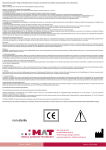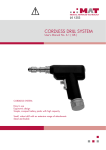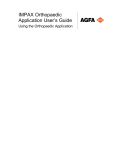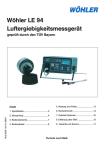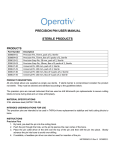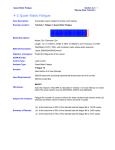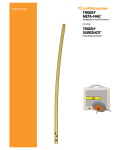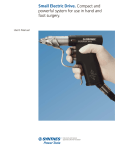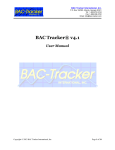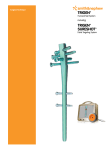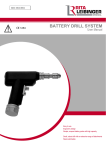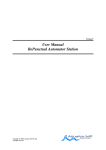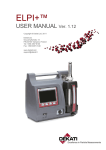Download mat lock humeral, anterograde and retrograde nail system
Transcript
MEDICAL ADVANCED TECHNOLOGY INTRAMEDULLARY NAILING - HUMERAL MAT LOCK HUMERAL, ANTEROGRADE AND RETROGRADE NAIL SYSTEM TITANIUM & STEEL NAIL SYSTEM HUMERAL NAILING IMPLANTS AND OPERATING MANUAL SOLUTION WITHOUT COMPROMISE introducing ourselve Manufacturer of surgical implants and medical devices. Solutions for patient orthopaedic and osteosyntheses fracture treatments, osteosyntheses customized orthopaedic innovations and solutions. corporate COMPANY philosophy, SOLUTION WITHOUT COMPROMISE MAT GmbH & Co. KG. design, develop and manufacture implants and instruments for use in specific treatments of trauma orthopedic systems, fracture reconstruction treatment systems. - Plate- and screw systems ( mini, small- and large fragment systems ) - Locking plate- and screw systems ( small- and large fragment systems ) - Interlocking nailing systems - Cranio maxillo facial plate- and screw systems - Cannulated screw system - Flexible reamer systems - Hand and Foot implants ( screws- and staple systems ) - External fixator systems - Oscillating saw blades - Power tool systems, battery- and air drive systems - General surgical instruments - Hemi arthroplasty instruments for hip surgeries and cement extraction MAT GmbH & Co. KG. innovative and exiting product portfolio is updated and expanded in line with technological advances to satisfy the current and future needs of both, patients and healthcare professionals. MAT GmbH & Co. KG. is committed to playing our part in achieving improved healthcare outcomes worldwide. 2| MAT Medical Advanced Technology GENERAL INFORMATION humeral NAILING before using the product Before every use you should carefully check the operability of the implants and the operating instruments. They should be free of damages. If there are any cracks, fractures, discolouration, deformation or any damages on the implants, which may be due to unsuitable storing, imperfect sterilization or preliminary inefficient treatment, the use of the implant is prohibited. The assembly, perfect fitting and operation of the implants and all the necessary instruments should be tested. Perfect fitting and operation, appropriate dimensions and positions should be checked in all cases. requirements towards the user The set of tools and implants can only be applied by doctors with appropriate qualifications and special information and experience in the field of using implants. The doctor who performs the operation is responsible for choosing the correct indication, the type of the implants and the operation technology. contraindication Implantation is not recommended if the patient's health condition makes it difficult to accept it or problems are expected during the recovery process e.g. decreased circulation, weak quality or quantity bone system, impossibility of rehabilitation due to the mental condition of the patient etc. general warnings Before the operation the patient should be informed about the possible disadvantages of the implant. By choosing the appropriate implant the type of the bone fracture, the weight and activity of the patient should be taken into consideration. The solidity of the implant is restricted, so it is necessary to avoid overloading it by overweight. The biomechanical loading of the implant should be minimized, as much as possible. During the application of the implant the process of recovering is to be controlled. By repetitive loading or by protracted bone recovering the implants may be deformed, dislocated. This needs intervention in time. Repeated deformation of the implant should be avoided. The implants are only for one-time use, a re-implantation is prohibited. The type and the size of the implants should be defined according to the specific case. Before operation the user's manual of the implants should be studied carefully. applied materials The applied materials are of best quality, specially developed for implants with high solidity, made of non magnetic stainless steel and titan alloys. Combined use of products of other manufacturers may start damaging processes, which the MAT GmbH & Co.KG can't take the responsibility for. protection of the product, packaging, preparation for use The implants come clean, without any production pollution for packaging. Before use circumstances are to be assured where the integrity of the packaging will be preserved. The storage should be in a clean, dry place avoiding extra temperature and chemicals. sterilisation Before use unpack the implant and sterilize due to the prescriptions. Avoid the touch by bare hand. The sterilisation of the instruments should be done together with the tray. The instructions of the producers should always be considered. interaction with medicines An interaction of the implants with medicines is not known. MAT Medical Advanced Technology | 3 SYSTEM OF IMPLANTS Material: steel or titanium alloy Locking humeral nail, cannulated, diameter 7 - 8 - 9 mm, cat. no.: from NA-14294-70180 to NA-14294-70310 (steel) from NA-34294-70180 to NA-34294-70310 (titanium alloy) from NA-14294-80180 to NA-14294-80310 (steel) from NA-34294-80180 to NA-34294-80310 (titanium alloy) from NA-14294-90180 to NA-14291-90310 (steel) from NA-34294-90180 to NA-34294-90310 (titanium alloy) Locking screw, diameter 3,9 mm, cat. no.: from LS-12200-39020 to LS-12200-39065 (steel) from LS-32200-39020 to LS-32200-39065 (titanium alloy) LS-12400-07011 (steel) LS-32400-07011 (titanium alloy) End cap, cat. no.: Surgical set for locking humeral nailing, cat. no.: SET-94290-00000 4| MAT Medical Advanced Technology implants for locking humeral nailing locking humeral nail, cannulated Catalogue Number L (mm) Ø7 steel titanium alloy steel Ø8 titanium alloy steel Ø9 titanium alloy 180 NA-14294-70180 NA-34294-70180 NA-14294-80180 NA-34294-80180 NA-14294-90180 NA-34294-90180 205 NA-14294-70205 NA-34294-70205 NA-14294-80205 NA-34294-80205 NA-14294-90205 NA-34294-90205 220 NA-14294-70220 NA-34294-70220 NA-14294-80220 NA-34294-80220 NA-14294-90220 NA-34294-90220 230 NA-14294-70230 NA-34294-70230 NA-14294-80230 NA-34294-80230 NA-14294-90230 NA-34294-90230 240 NA-14294-70240 NA-34294-70240 NA-14294-80240 NA-34294-80240 NA-14294-90240 NA-34294-90240 250 NA-14294-70250 NA-34294-70250 NA-14294-80250 NA-34294-80250 NA-14294-90250 NA-34294-90250 260 NA-14294-70260 NA-34294-70260 NA-14294-80260 NA-34294-80260 NA-14294-90260 NA-34294-90260 270 NA-14294-70270 NA-34294-70270 NA-14294-80270 NA-34294-80270 NA-14294-90270 NA-34294-90270 280 NA-14294-70280 NA-34294-70280 NA-14294-80280 NA-34294-80280 NA-14294-90280 NA-34294-90280 295 NA-14294-70295 NA-34294-70295 NA-14294-80295 NA-34294-80295 NA-14294-90295 NA-34294-90295 310 NA-14294-70310 NA-34294-70310 NA-14294-80310 NA-34294-80310 NA-14294-90310 NA-34294-90310 locking screw Thread diameter: 3,9 mm Pitch: 1,75 mm L (mm) steel 20 LS-12200-39020 end cAp for locking humeral nail Core diameter: 3,2 mm Hex width: 2,5 mm Catalogue Number Catalogue Number Catalogue Number titanium alloy L (mm) steel titanium alloy steel titanium alloy LS-32200-39020 44 LS-12200-39044 LS-32200-39044 LS-12400-07011 LS-32400-07011 22 LS-12200-39022 LS-32200-39022 45 LS-12200-39045 LS-32200-39045 24 LS-12200-39024 LS-32200-39024 46 LS-12200-39046 LS-32200-39046 26 LS-12200-39026 LS-32200-39026 48 LS-12200-39048 LS-32200-39048 28 LS-12200-39028 LS-32200-39028 50 LS-12200-39050 LS-32200-39050 30 LS-12200-39030 LS-32200-39030 52 LS-12200-39052 LS-32200-39052 LS-32200-39054 32 LS-12200-39032 LS-32200-39032 54 LS-12200-39054 34 LS-12200-39034 LS-32200-39034 55 LS-12200-39055 LS-32200-39055 35 LS-12200-39035 LS-32200-39035 56 LS-12200-39056 LS-32200-39056 36 LS-12200-39036 LS-32200-39036 58 LS-12200-39058 LS-32200-39058 38 LS-12200-39038 LS-32200-39038 60 LS-12200-39060 LS-32200-39060 40 LS-12200-39040 LS-32200-39040 65 LS-12200-39065 LS-32200-39065 42 LS-12200-39042 LS-32200-39042 MAT Medical Advanced Technology | 5 SURGICAL INSTRUMENTS FOR locking humeral nailing surgical set Cat. no.: SET -94290-00000 Cat. no.: TRAY-94290-00000 Tray for humeral nailing instrument set Pos. Cat.no. Description 1 INS-94290-00105 Fixing screw, M8 pcs Pos. Cat.no. Description 1 14 INS-94290-00600 Threaded removal shaft 2 INS-94290-00100 Proximal targeting arm 3 INS-94290-00503 M5 screw for auxiliary arm and targeting shaft 4 INS-94290-00500 Auxiliary targeting arm 1 pcs 1 15 INS-99000-00008 Wrench, 11 mm 1 5 16 INS-15000-20250 Kirschner-wire, 2 x 250 mm 3 17 INS-99010-32190 Spiral drill, quick coupling, 3,2 x 190 mm 1 1 5 INS-94290-00400 Threaded stem, cannulated 1 18 INS-99010-45145 Spiral drill, 4,5 x 145 mm 1 6 INS-99000-00009 Wrench, 17 mm 1 19 INS-94290-01500 Screw length gauge 1 7 INS-94290-00103 Targeting shaft left (retrograde), right (anterograde) 1 20 INS-94290-01700 Length gauge 1 8 INS-94290-00104 Targeting shaft right (retrograde), left (anterograde) 1 21 INS-94290-01800 Burr 1 22 INS-94290-01003 Removal - impactor bumper 1 23 INS-99031-10200 Spiral drill, cannulated, 10/2,2 x 200 mm 1 24 INS-94290-01100 Hammer 1 25 INS-94290-01300 Drill sleeve 6/3,2 mm 2 26 INS-99000-00012 Quick coupling handle 1 27 INS-94290-01200 Pointer 1 28 INS-94290-01000 Removal - impactor shaft 1 9 INS-94290-00700 Reamer 10 mm, cannulated 1 10 INS-99150-35106 Screw driver, quick coupling, 3,5 x 106 mm 1 INS-99150-25150 Screw driver, quick coupling, 2,5 x 150 mm 1 12 INS-94290-01600 Impactor, cannulated 1 13 INS-94290-01400 Soft tissue protector, 8/6 mm 2 11 6| MAT Medical Advanced Technology implants for locking humeral nailing Pos. 1 Pos. 2 Pos. 3 Pos. 4 Pos. 5 Pos. 6 Pos. 7 Pos. 8 Pos. 9 Pos. 10 Cat. no. Description INS-94290-00105 Fixing screw, M8 Cat. no. Description INS-94290-00100 Proximal targeting arm Cat. no. Description INS-94290-00503 M5 screw for auxiliary arm and targeting shaft Cat. no. Description INS-94290-00500 Auxiliary targeting arm Cat. no. Description INS-94290-00400 Threaded stem, cannulated Cat. no. Description INS-99000-00009 Wrench, 17 mm Cat. no. Description INS-94290-00103 Targeting shaft, left (retrograde), right (anterograde) Cat. no. Description INS-94290-00104 Targeting shaft, right (retrograde), left (anterograde) Cat. no. Description INS-94290-00700 Reamer 10 mm, cannulated Cat. no. Description INS-99150-35106 Screw driver, quick coupling, 3,5 x 106 mm MAT Medical Advanced Technology | 7 pcs 1 pcs 1 pcs 5 pcs 1 pcs 1 pcs 1 pcs 1 pcs 1 pcs 1 pcs 1 SURGICAL INSTRUMENTS FOR locking humeral nailing Pos. 11 Pos. 12 Pos. 13 Pos. 14 Pos. 15 Pos. 16 Pos. 17 Pos. 18 Pos. 19 8| MAT Medical Advanced Technology Cat. no. Description INS-99150-25150 Screw driver, quick coupling, 2,5 x 150 mm Cat. no. Description INS-94290-01600 Impactor, cannulated Cat. no. Description INS-94290-01400 Soft tissue protector, 8/6 mm Cat. no. Description INS-94290-00600 Threaded removal shaft Cat. no. Description INS-99000-00008 Wrench, 11 mm Cat. no. Description INS-15000-20250 Kirschner-wire, 2 x 250 mm Cat. no. Description INS-99010-32190 Spiral drill, quick coupling, 3,2 x 190 mm Cat. no. Description INS-99010-45145 Spiral drill, 4,5 x 145 mm Cat. no. Description INS-94290-01500 Screw length gauge pcs 1 pcs 1 pcs 2 pcs 1 pcs 1 pcs 3 pcs 1 pcs 1 pcs 1 implants for locking humeral nailing Pos. Cat. no. Description 20 INS-94290-01700 Length gauge Pos. Cat. no. Description INS-94290-01800 Burr 21 Pos. 22 Pos. 23 Pos. 24 Pos. 25 Cat. no. Description INS-94290-01003 Removal - impactor bumper Cat. no. Description INS-99031-10200 Spiral drill, cannulated, 10/2,2 x 200 mm Cat. no. Description INS-94290-01100 Hammer Cat. no. Description INS-94290-01300 Drill sleeve 6/3,2 mm Pos. Cat. no. Description 26 INS-99000-00012 Quick coupling handle Pos. Cat. no. Description INS-94290-01200 Pointer Cat. no. Description INS-94290-01000 Removal - impactor shaft 27 Pos. 28 MAT Medical Advanced Technology | 9 pcs 1 pcs 1 pcs 1 pcs 1 pcs 1 pcs 2 pcs 1 pcs 1 pcs 1 The Humerus Nail of MAT GmbH & Co. KG due to AO classification A,B and C types fit to all 3 subtypes for operation of fractures. The correct placing of the nail depending on the direction of the insertion, do according to the medical prescriptions and the international literature. 1 2 For choosing the necessary implant with the help of Xray we define the appropriate sizes. Knowing the length and diameter of the nail we assemble the prepared implant with the aimer. (2 - a proximal targeting arm, 5 – threaded stem, 7, 8 right-hand or left targeting shaft, 1 - a fixing screw). We check fitting up, the punctuality of the borings, the anatomically correct position of the nail, the stiffness of the links. 3 4 Define the point of insertion. Preparing countersink holes with 4.5 × 145 mm spiral drill (18). 4/a Alternative technique: If the bone fracture requires, for effectiveness of the reposition we can choose either a leader-split. In this case we drill the penetration pont by Kirshner wire (16) we drive the wire in the necessary way of the intramedullary .The loose end of the wire with the help of the measuring strip (20) can identify the length of the nail. 5 With the burr (21) we expand and fuse the countersink holes. With this we prepare the point of inserting the nail. 5/a Alternative technique We expand the penetration point - keeping the split (16)by cannulated hand miller and / or cannulated spiral drill. 10 | MAT Medical Advanced Technology surgical technique with retrograde insertion 6 We insert the nail assembled with the targeting arm (2), (7-8), (1) and with the impactor shaft (28), (24) into the medullary canal. We check the proper position with X-ray. If necessary we help the inserting with mild beats (24). After reaching the wished position we remove the impactor shaft (28). 6/a Alternative technique: We fix to the cannulated impactor – which connect the nail and the targeting arm- the cannulated stem.The driving in of the nail takes place with the driving of the Kirschner. If necessary we can hammer slight the nail by the cannulated stem - we need to avoid any further damages and crack of the bone. 7 We carry out first the proximal locking, to which we look for the position of the locking borings with bi-directional X-ray control. Using the soft tissue protector (13) and drill sleeve (25) with use of 3.2 × 190 mm spiral drill (17) we prepare a locking boring. 7/a Alternative technique: If we used Kirshner leader split for driving in the nail, we need to remove it from the intramedullary before locking. Then remove the cannulated stem from impactor. 8 9 Keeping the soft tissue protector we define the length of the proper locking screw. For this we fix the length gauge (19) into the opposite corticalis through the locking boring. The size shown on the soft tissue protector matches the length of the screw. Installing the locking screws is to be done through the soft tissue protector (13). We put the steam of the screw driver 2,5 × 150 mm (11) into the quick coupling handle (26) and lock with the chosen screws. MAT Medical Advanced Technology | 11 1.5 surgical technique with retrograde insertion 10 The distal locking is to be done with the targeting device assembled to the nail. For the lateral locking we place a soft tissue protector (13 ) and a drill sleeve (25) into the hole of the targeting arm (7, 8). On the prepared boring with spiral drill 3,2 × 190mm (17) we do a length measuring like by the proximal locking and screw in the necessary locking screws. If the direction of the fracture requires, we can do sagittal locking as well.In order to do it we have to use the auxiliary targeting arm (4) with a fixing screw (3). Preparing locking, the length measuring and locking is the same as previously described. 11 12 13 14 12 | MAT Medical Advanced Technology After finishing the locking we remove the targeting device (2),(7-8), (4) with the wrench (6), put an end cup into the nail and close the cut. After the operation we check the reconstruction of the function of the shoulder. During the recovering process we control several times the process of the recovering. We control the position of the implants as needed but at least after 2 days and after 6 and 12 weeks with X-ray as well. At appropriate stage of the bone-regeneration we can remove the medullary nail. At first we take out the locking screws then with removing the end cup we open the threaded link at the end of the nail. We screw the threaded removal shaft (14) into the end of the nail, than fix the removal shaft (28) on it. We place the hammer (24) and close the shaft with the removal bumper (22). We remove the nail with indulgent use of the hammer. surgical technique with anterograde insertion 1 2 For choosing the necessary implant with the help of Xray we define the appropriate sizes. Knowing the length and diameter of the nail we assemble the prepared implant with the aimer. (2 - a proximal targeting arm, 5 – threaded steam, 7, 8 - righthand or left targeting shaft, 1 - a fixing screw). We check fitting up, the punctuality of the borings, the anatomically correct position of the nail, the stiffness of the links. 3 4 Draw aside the muscle fibres, then define the point of insertion. Open the medullary canal with 2 × 250 mm Kirschner wire (16). While keeping the muscle fibres drawn aside using the correct position of the leader-spit (16) we enlarge the insertion point with the reamer (9) to the size of the nail. We remove both the spit (16) and the reamer (9). 4/a Alternative technique: If the bone fracture requires, for effectiveness of the reposition we can choose either a leader-split. In this case we drill the penetration pont by Kirshner wire (16) we drive the wire in the necessary way of the intramedullary .The loose end of the wire with the help of the measuring strip (20) can identify the length of the nail. 5 We insert the nail assembled with the targeting arm (2), (7-8), (1) and with the impactor shaft (28), and the hammer (24) into the medullary canal. In case of the right nail position the end of the nail must be in any case under the cartilage surface. We check the proper position with X-ray. The image of the Kirschner wire led through the targeting arm helps to control the right position of the nail. After reaching wished position we remove the impactor shaft (28) and the hammer (24). 5/a Alternative technique We expand the penetration point - keeping the split (16)by cannulated hand miller and / or cannulated spiral drill. MAT Medical Advanced Technology | 13 6 We begin locking on the distal end. We look for the position of the locking borings with bi-directional X-ray control. If necessary before drilling the lateral locking hole we can help through the soft tissue protector (13) with the use of pointer (27). 6/a A alternative technique: We fix to the cannulated impactor – which connect the nail and the targeting arm- the cannulated stem.The driving in of the nail takes place with the driving of the Kirschner. If necessary we can hammer slight the nail by the cannulated stem - we need to avoid any further damages and crack of the bone. 7 We carry out first the distal locking, to which we look for the position of the locking borings with bi-directional Xray control. Using the soft tissue protector (13) and drill sleeve (25) with use of 3.2 × 190 mm spiral drill (17) we prepare a locking boring. 7/a Alternative technique: If we used Kirshner leader split for driving in the nail, we need to remove it from the intramedullary before locking. Then remove the cannulated stem from impactor. 14 | MAT Medical Advanced Technology 8 Keeping the soft tissue protector we define the length of the proper locking screw. For this we fix the length gauge (19) into the opposite corticalis through the locking boring. The size shown on the soft tissue protector matches to the length of the screw. 9 Installing of the locking screws is to be done through the soft tissue protector (13). We put the steam of the screw driver (11) into the quick coupling handle (26) and lock with the chosen screws. surgical technique with anterograde insertion 10 11 12 13 14 The distal locking is to be done with the targeting device assembled to the nail. For the lateral locking we place a soft tissue protector (13) and a drill sleeve (25) into the hole of the targeting arm (7, 8). On the prepared boring with spiral drill (17) we do a length measuring like by the proximal locking and screw in the necessary locking screws. If the direction of the fracture requires we can do sagittal locking as well. In order to do it we have to use the auxiliary targeting arm (4) with a fixing screw (3). The preparing locking, the length measuring and the locking is the same as previously described. After finishing locking we remove the targeting device (2),(7-8), (4) with the wrench (15), put an end cup into the nail and close the cut. After the operation we check the reconstruction of the function of the shoulder. During the recovering process we control several times the process of the recovering. We control the position of the implants as needed but at least after 2 days and after 6 and 12 weeks with X-ray as well. At appropriate stage of the bone-regeneration we can remove the medullary nail. At first we take out the locking screws then with removing the end cup we open the threaded link at the end of the nail. We screw the threaded removal shaft (14) into the end of the nail, than fix the removal shaft (28) on it. We place the hammer (24) and close the shaft with the removal bumper (22). We remove the nail with indulgent use of the hammer. MAT Medical Advanced Technology | 15 MEDICAL ADVANCED TECHNOLOGY Intramedullary Nailing - Humeral © MAT / AtelierUrban MAT GmbH & Co.KG Friedrich-Wöhler Straße 10 78576 Emmingen-Liptingen, Germany Phone: +49 (0)7465 909 188 ∙ Fax : +49 (0)7465 909 024 www.mat-medical.com · [email protected] Revision 10.07.2012
















